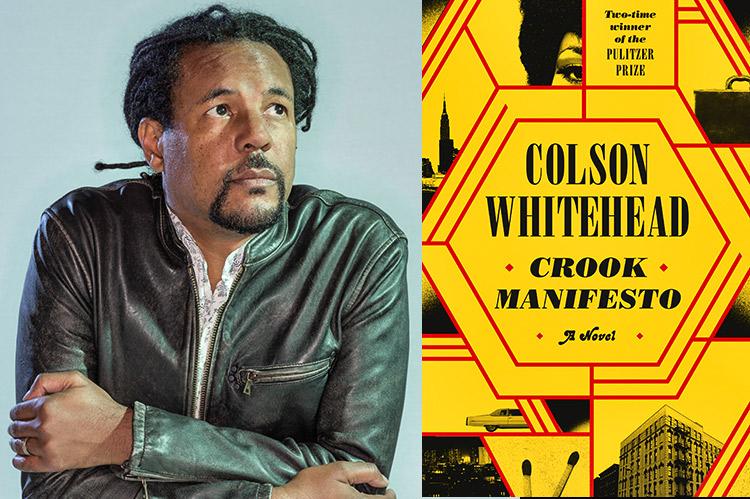“Crook Manifesto”
Colson Whitehead
Doubleday, $29
"Crook Manifesto" by Colson Whitehead is an intriguing look at Harlem in the 1970s, where residents hustle to stay ahead in a city that is failing, and a neighborhood that is failing faster.
Told in three parts, set in 1971, 1973, and 1976, the novel has Ray Carney as its protagonist. Carney, star of the Whitehead novel "Harlem Shuffle," has a furniture store on 125th Street, and supplements his income by fencing stolen goods for local gangsters, which he calls the "secondhand rug business."
Carney learned the finer points of fencing from his father, Big Mike. Between his day job and after-dark activities, Carney is earning a comfortable living, and even owns a couple buildings.
The first part of the novel, titled "Ringolevio," sees Carney working to put the shady stuff behind him. But his daughter desperately wants Jackson 5 tickets, which are about as easy to secure as Taylor Swift tickets in 2023. So Carney looks up a man from his former life, a dodgy police officer named Munson who is known as a fixer of problems, such as one's lack of Jackson 5 ducats. Munson makes some tough demands of Carney that see him knee-deep in skulduggery once again.
The second part, "Nefertiti T.N.T.," focuses on a thug named Pepper, who pulled off jobs with Big Mike, and later with Carney. Pepper, described as "a six-foot frown molded by black magic into human form," picks up a side job handling security for a blaxploitation movie being shot in Harlem, and encounters a dizzying array of Hollywood types finding their way around the neighborhood.
Part three, "The Finishers," looks at the startling number of buildings burning down in Harlem, detailing both the opportunist fire-starters out to make a buck and the "firebugs" who simply get off on massive blazes. ("The Bronx Is Burning" focused on another part of the city, but Upper Manhattan had its share of arson in the '70s.) When a child in one of the buildings Carney owns is injured in a fire, he taps Pepper to dig into who is responsible. Pepper being Pepper, madness and violence ensue.
Mr. Whitehead is as decorated as any living novelist, with Pulitzer Prizes for "The Nickel Boys" and "The Underground Railroad." A recipient of MacArthur and Guggenheim fellowships, his other novels include "Sag Harbor," about a teen spending his summer at a historically Black beach resort, and "Harlem Shuffle," about Ray Carney in the late 1950s and early '60s, getting his furniture store going, and a robbery heist that goes wrong.
Mr. Whitehead writes of '70s Harlem with exquisite detail, from the streets and shops to the subways that traverse it, and the denizens who walk its streets and ride its trains. About those who graffiti the subway cars, he writes, "The clack-clack of the metal ball inside that agitated the paint while they contemplated their next avenue of assault. Names, deadbeat slogans, boasts, and invective exploded on the train cars in balloon letters and sharp-angled glyphs, rainbow dispatches for the people on platforms and the bystanders on the street who saw them zipping through the air on the elevated tracks."
The reader picks up plenty of Harlem history, including that of Strivers' Row, where the Carney family resides, along 138th and 139th Streets. One also learns a bit about furniture. "The sleek silhouette that had been omnipresent a few years before, all those jet-age lines and tapers, was yesterday's news," Mr. Whitehead writes. "Overflowing sofas, chubby ottomans, and plush, bulging armchairs surrounded him in the showroom. Country in a recession, everybody feeling the pinch, but you can enjoy your comfy throne at home."
As much as the reader learns about Black residents in 1970s Harlem, including their motivations and concerns, Mr. Whitehead also offers takes on how that community viewed privileged white citizens in other neighborhoods. As Pepper rides the subway, he notes the shuttered "ghost stations" downtown. "White people were lazy back then," he thinks, and didn't want to walk several blocks to the station.
"Crook Manifesto" is about cities as much as it is about city residents — buildings get knocked down, or burned down, and new buildings go up, people move out, new people move in, and the dynamic shifts daily.
There are a lot of gangsters to keep straight, from bosses like Notch Walker and Chink Montague to bit players like Smiling Rick. One may wish for a bit more overlap in the three stories, and recurring main characters other than Carney and Pepper. But Mr. Whitehead succeeds in delivering a rich snapshot of a place, a time, and a people.
Carney suffers a harrowing setback in the third and final story, but in the end comes up with an inspired thought that resonates around this time of year. Overwhelmed by all the rah-rah America sentiment flying around the bicentennial, Carney envisions his own take on the Spirit of '76 — marching Black musicians playing fife and drums amid the city's gray pallor, pigeons flying above, a row of bleak tenements in the backdrop. It would make a heckuva mural, he thinks, on the side of his shop.
"This is their march — folly, fortitude, and that brand of determination that comes from ignoring reality," Mr. Whitehead writes.
Carney will think on the mural some more, but has more pressing matters — his shop, his family, his burning neighborhood — to deal with.
Michael Malone's writing has appeared in The New York Times and The Philadelphia Inquirer. He grew up on Long Island.
Colson Whitehead lives part time in Sag Harbor. "Crook Manifesto" comes out on July 18.

